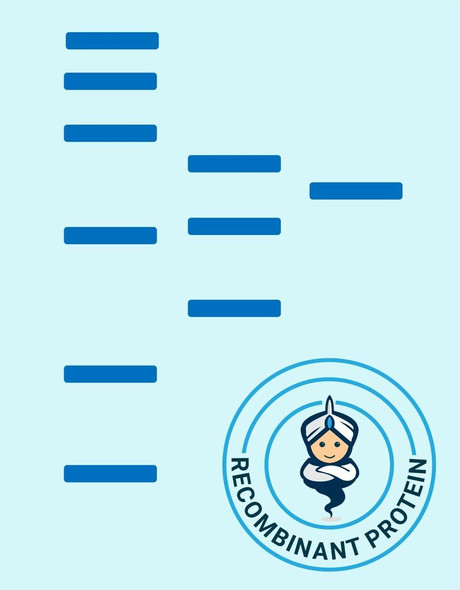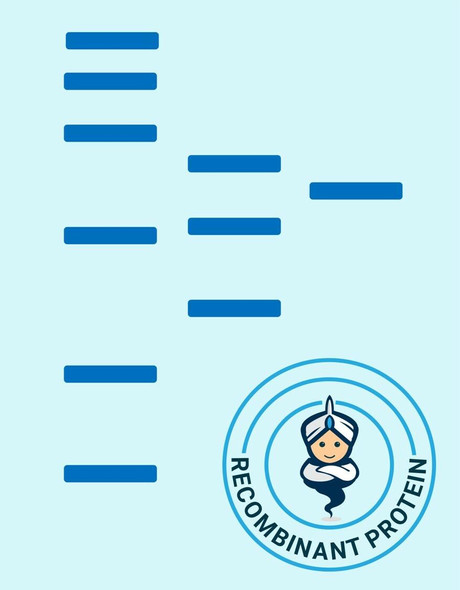Description
| Product Name: | Human sRANKL Recombinant Protein |
| Product Code: | RPPB0912 |
| Size: | 10µg |
| Species: | Human |
| Target: | sRANKL |
| Synonyms: | Soluble Receptor Activator of NFkB Ligand, TNFSF11, TRANCE, TNF-related activation-induced cytokine, OPGL, ODF, Osteoclast differentiation factor, Tumor necrosis factor ligand superfamily member 11, Receptor activator of nuclear factor kappa B ligand, RANKL, Osteoprotegerin ligand, CD254 antigen, sRANKL, sOdf, hRANKL2. |
| Source: | Escherichia Coli |
| Physical Appearance: | Sterile Filtered White lyophilized (freeze-dried) powder. |
| Formulation: | The protein was lyophilized from a concentrated (1mg/ml) solution containing 10mM Sodium phosphate, pH-7.5. |
| Solubility: | It is recommended to reconstitute the lyophilized sRANKL in sterile 18M?-cm H2O at a concentration of 100�g/ml, which can then be further diluted to other aqueous solutions. |
| Stability: | Lyophilized TNFSF11 although stable at room temperature for 3 weeks, should be stored desiccated below -18°C. Upon reconstitution sRANKL should be stored at 4°C between 2-7 days and for future use below -18°C.For long term storage it is recommended to add a carrier protein (0.1% HSA or BSA).Please prevent freeze-thaw cycles. |
| Purity: | Greater than 95.0% as determined by analysis by SDS-PAGE. |
| Amino Acid Sequence: | EKAMVDGSW LDLAKRSKLE AQPFAHLTIN ATDIPSGSHK VSLSSWYHDR GWAKISNMTF SNGKLIVNQD GFYYLYANIC FRHHETSGDL ATEYLQLMVY VTKTSIKIPS SHTLMKGGST KYWSGNSEFH FYSINVGGFF KLRSGEEISI EVSNPSLLDP DQDATYFGAF KVRDID |
| Biological Activity: | The activity of RAW-Blue was measured to be 38.8 ng/ml, corresponding to a specific activity of 2.6x104 units/mg. |
RANKL binds to tnfrsf11b/opg and to tnfrsf11a/rank. Osteoclast differentiation and activation factor. Augments the ability of dendritic cells to stimulate naive t-cell proliferation. May be an important regulator of interactions between t-cells and dendritic cells and may play a role in the regulation of the t-cell-dependent immune response. sRANKL may also play an important role in enhanced bone-resorption in humoral hypercalcemia of malignancy.
sRANKL Human Recombinant produced in E.Coli is a single, non-glycosylated polypeptide chain containing 175 amino acids and having a molecular mass of 19.7kDa.
| UniProt Protein Function: | TNFSF11: Cytokine that binds to TNFRSF11B/OPG and to TNFRSF11A/RANK. Osteoclast differentiation and activation factor. Augments the ability of dendritic cells to stimulate naive T-cell proliferation. May be an important regulator of interactions between T-cells and dendritic cells and may play a role in the regulation of the T-cell-dependent immune response. May also play an important role in enhanced bone-resorption in humoral hypercalcemia of malignancy. Homotrimer. Up-regulated by T-cell receptor stimulation. Highest in the peripheral lymph nodes, weak in spleen, peripheral blood Leukocytes, bone marrow, heart, placenta, skeletal muscle, stomach and thyroid. Belongs to the tumor necrosis factor family. 3 isoforms of the human protein are produced by alternative splicing. |
| UniProt Protein Details: | Protein type:Membrane protein, integral Chromosomal Location of Human Ortholog: 13q14 Cellular Component: extracellular space; integral to plasma membrane; cytoplasm; extracellular region Molecular Function:cytokine activity; tumor necrosis factor receptor superfamily binding; tumor necrosis factor receptor binding Biological Process: ossification; positive regulation of I-kappaB kinase/NF-kappaB cascade; positive regulation of osteoclast differentiation; cytokine and chemokine mediated signaling pathway; mammary gland epithelial cell proliferation; osteoclast differentiation; activation of JNK activity; positive regulation of corticotropin-releasing hormone secretion; positive regulation of homotypic cell-cell adhesion; activation of NF-kappaB transcription factor; calcium ion homeostasis; monocyte chemotaxis; positive regulation of protein kinase B signaling cascade; positive regulation of MAP kinase activity; organ morphogenesis; tumor necrosis factor-mediated signaling pathway; positive regulation of bone resorption; immune response; positive regulation of transcription from RNA polymerase II promoter; positive regulation of transcription factor activity; positive regulation of T cell activation; protein homooligomerization; bone resorption Disease: Osteopetrosis, Autosomal Recessive 2 |
| NCBI Summary: | This gene encodes a member of the tumor necrosis factor (TNF) cytokine family which is a ligand for osteoprotegerin and functions as a key factor for osteoclast differentiation and activation. This protein was shown to be a dentritic cell survival factor and is involved in the regulation of T cell-dependent immune response. T cell activation was reported to induce expression of this gene and lead to an increase of osteoclastogenesis and bone loss. This protein was shown to activate antiapoptotic kinase AKT/PKB through a signaling complex involving SRC kinase and tumor necrosis factor receptor-associated factor (TRAF) 6, which indicated this protein may have a role in the regulation of cell apoptosis. Targeted disruption of the related gene in mice led to severe osteopetrosis and a lack of osteoclasts. The deficient mice exhibited defects in early differentiation of T and B lymphocytes, and failed to form lobulo-alveolar mammary structures during pregnancy. Two alternatively spliced transcript variants have been found. [provided by RefSeq, Jul 2008] |
| UniProt Code: | O14788 |
| NCBI GenInfo Identifier: | 12643360 |
| NCBI Gene ID: | 8600 |
| NCBI Accession: | O14788.1 |
| UniProt Secondary Accession: | O14788,O14723, Q96Q17, Q9P2Q3, |
| UniProt Related Accession: | O14788 |
| Molecular Weight: | 30,523 Da |
| NCBI Full Name: | Tumor necrosis factor ligand superfamily member 11 |
| NCBI Synonym Full Names: | tumor necrosis factor (ligand) superfamily, member 11 |
| NCBI Official Symbol: | TNFSF11�� |
| NCBI Official Synonym Symbols: | ODF; OPGL; sOdf; CD254; OPTB2; RANKL; TRANCE; hRANKL2�� |
| NCBI Protein Information: | tumor necrosis factor ligand superfamily member 11; osteoprotegerin ligand; osteoclast differentiation factor; TNF-related activation-induced cytokine; receptor activator of nuclear factor kappa B ligand; receptor activator of nuclear factor kappa-B ligand |
| UniProt Protein Name: | Tumor necrosis factor ligand superfamily member 11 |
| UniProt Synonym Protein Names: | Osteoclast differentiation factor; ODF; Osteoprotegerin ligand; OPGL; Receptor activator of nuclear factor kappa-B ligand; RANKL; TNF-related activation-induced cytokine; TRANCE; CD_antigen: CD254Cleaved into the following 2 chains:Tumor necrosis factor ligand superfamily member 11, membrane form; Tumor necrosis factor ligand superfamily member 11, soluble form |
| UniProt Gene Name: | TNFSF11�� |
| UniProt Entry Name: | TNF11_HUMAN |









